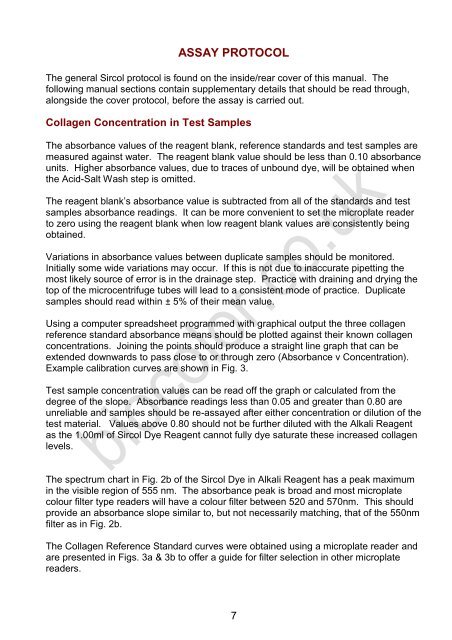Sircol Assay Manual - Biocolor Assays
Sircol Assay Manual - Biocolor Assays
Sircol Assay Manual - Biocolor Assays
Create successful ePaper yourself
Turn your PDF publications into a flip-book with our unique Google optimized e-Paper software.
ASSAY PROTOCOL<br />
The general <strong>Sircol</strong> protocol is found on the inside/rear cover of this manual. The<br />
following manual sections contain supplementary details that should be read through,<br />
alongside the cover protocol, before the assay is carried out.<br />
Collagen Concentration in Test Samples<br />
The absorbance values of the reagent blank, reference standards and test samples are<br />
measured against water. The reagent blank value should be less than 0.10 absorbance<br />
units. Higher absorbance values, due to traces of unbound dye, will be obtained when<br />
the Acid-Salt Wash step is omitted.<br />
The reagent blank’s absorbance value is subtracted from all of the standards and test<br />
samples absorbance readings. It can be more convenient to set the microplate reader<br />
to zero using the reagent blank when low reagent blank values are consistently being<br />
obtained.<br />
Variations in absorbance values between duplicate samples should be monitored.<br />
Initially some wide variations may occur. If this is not due to inaccurate pipetting the<br />
most likely source of error is in the drainage step. Practice with draining and drying the<br />
top of the microcentrifuge tubes will lead to a consistent mode of practice. Duplicate<br />
samples should read within ± 5% of their mean value.<br />
Using a computer spreadsheet programmed with graphical output the three collagen<br />
reference standard absorbance means should be plotted against their known collagen<br />
concentrations. Joining the points should produce a straight line graph that can be<br />
extended downwards to pass close to or through zero (Absorbance v Concentration).<br />
Example calibration curves are shown in Fig. 3.<br />
Test sample concentration values can be read off the graph or calculated from the<br />
degree of the slope. Absorbance readings less than 0.05 and greater than 0.80 are<br />
unreliable and samples should be re-assayed after either concentration or dilution of the<br />
test material. Values above 0.80 should not be further diluted with the Alkali Reagent<br />
as the 1.00ml of <strong>Sircol</strong> Dye Reagent cannot fully dye saturate these increased collagen<br />
levels.<br />
The spectrum chart in Fig. 2b of the <strong>Sircol</strong> Dye in Alkali Reagent has a peak maximum<br />
in the visible region of 555 nm. The absorbance peak is broad and most microplate<br />
colour filter type readers will have a colour filter between 520 and 570nm. This should<br />
provide an absorbance slope similar to, but not necessarily matching, that of the 550nm<br />
filter as in Fig. 2b.<br />
The Collagen Reference Standard curves were obtained using a microplate reader and<br />
are presented in Figs. 3a & 3b to offer a guide for filter selection in other microplate<br />
readers.<br />
7


